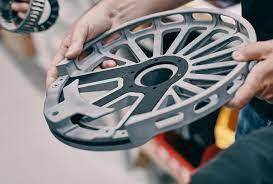Nylon PA12 and Nylon PA11: Why PA12 remains the Top Choice for Industrial 3D Printing
- cvanhoogevest
- May 21, 2023
- 3 min read
Updated: Nov 11
Over the past decade, 3D printing has evolved from a rapid prototyping tool into a full-scale manufacturing technology, thanks to innovations in materials like nylon. Among the family of engineering-grade nylons, Nylon PA12 has become the most widely adopted material for industrial 3D printing, particularly with HP Multi Jet Fusion (MJF) technology. Its excellent balance of strength, dimensional stability, and durability make it ideal for high-performance, production-grade parts.
While Nylon PA11 and Nylon PA12 share similar chemistry, their subtle molecular differences lead to distinct material behaviors — and for most end-use manufacturing, PA12 offers a more consistent, versatile, and cost-effective solution. HP Multi Jet Fusion 3D printing technology.

About Nylon
.Nylons are a family of polyamides made by combining carbon-based compounds under high temperature and pressure. The resulting polymer chains give nylon its hallmark strength, flexibility, and long-term resilience.
The numbers following “PA” (Polyamide) — such as PA11 and PA12 — indicate the number of carbon atoms in their monomer chain. This small variation creates meaningful differences in performance, processing, and application.
Nylon PA11 and Nylon PA12: Key Differences
Chemically similar yet functionally distinct, Nylon PA12 and Nylon PA11 perform differently under industrial conditions:
Nylon PA12 is a synthetic polyamide derived from petroleum feedstock, offering exceptional consistency and stability in production. It exhibits superior dimensional accuracy, low moisture absorption, and excellent chemical resistance, making it ideal for parts that demand tight tolerances and reliable performance over time.
Nylon PA11 produced from renewable castor oil, is valued for its sustainability and slightly higher elasticity. However, it can be more variable in mechanical performance, less dimensionally stable, and more expensive to produce than PA12.
Advantages of Nylon PA12 for HP Multi Jet Fusion

Nylon PA12 is the gold standard for HP’s MJF technology and remains the most commonly used nylon powder for industrial 3D printing. Its exceptional properties include:
Excellent chemical resistance to oils, fuels, grease, solvents, salts, and water
High dimensional accuracy and low water absorption, ensuring stability even in humid environments
Outstanding wear and abrasion resistance, ideal for mechanically stressed parts
Temperature stability across a wide range, performing reliably even in freezing conditions
Smooth surface finish and fine detail resolution, reducing post-processing time
Proven long-term durability, suitable for demanding applications across medical, aerospace, and automotive industries
These attributes make PA12 a true workhorse material — perfect for functional prototypes, end-use components, and production-grade assemblies.
When to Use Nylon PA11

Nylon PA11 still has its place, particularly when flexibility, impact resistance, or biobased sourcing is the top priority. It performs well in applications that require ductility, such as living hinges or moving parts. However, its higher material cost and slightly lower stiffness make it less common for large-scale production where repeatability and precision are essential.
Conclusion
Both PA11 and PA12 are high-performance nylons well-suited for 3D printing — but PA12 stands out as the most versatile and reliable option for industrial manufacturing. Its excellent balance of strength, accuracy, chemical resistance, and long-term stability make it the clear choice for businesses seeking consistent, production-ready parts from HP Multi Jet Fusion systems.
Whether you’re developing functional prototypes or producing end-use components, Nylon PA12 delivers the best combination of performance, quality, and scalability for modern additive manufacturing
Ready for your next project?
To learn more about the material properties and end-use applications of nylon and other engineering-grade 3D printing plastics which are 3D printed with HP Multi Jet Fusion technology, check out Tempus 3D’s materials comparison page. If you are ready to create your next project, visit our online quote and ordering page for pricing and ordering details. .
Tempus 3D is a Canadian 3D printing service bureau which specializes in manufacturing affordable, high-quality engineering-grade plastics using industry-leading HP Multi Jet Fusion 3D printing technology.
Sources: www.hp.com/us-en/printers/3d-printers/products/multi-jet-technology.html, www.weerg.com/guides/nylon-pa-11-vs-pa-12. Images courtesy of HP.






